How to install an outdoor shower: top DIY tips for this refreshing backyard feature
Our advice on how to install an outdoor shower will help you get successful results for your own garden project
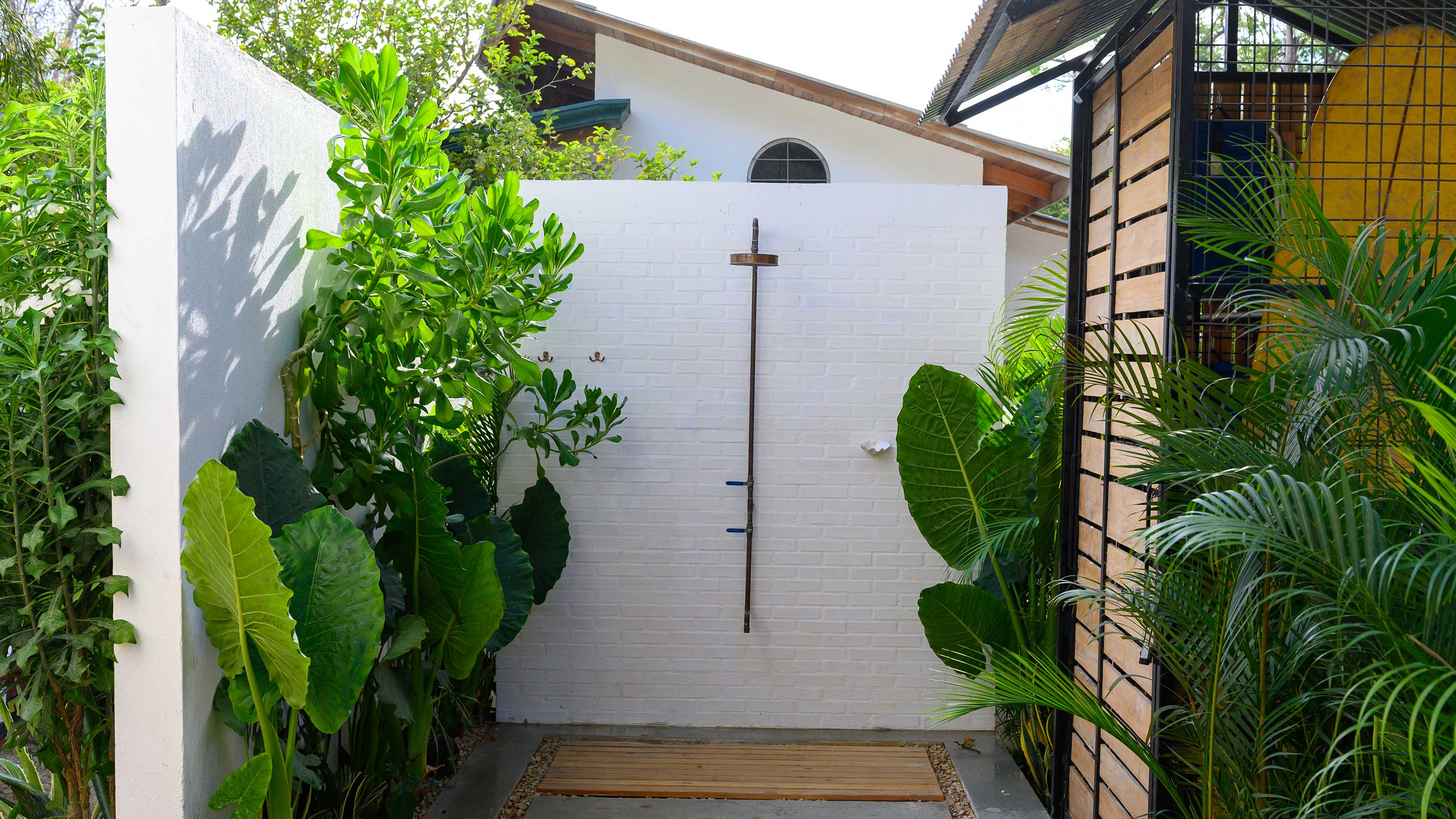

Want some advice on how to install an outdoor shower? You've come to the right place. If you fancy taking on this DIY project, we've rounded up plenty of helpful tips to ensure it's a success.
Outdoor shower ideas are rising in popularity, becoming an on-trend addition to backyard living spaces both great and small. You can go for a simple yet chic design, while some encapsulate the feeling of a private alfresco spa – but whatever look you go for, they're definitely practical.
For rinsing muddy pets or feet, cooling off on a hot summer's day, using just before taking a dip in your pool, or simply having some luxurious 'you time' out in the fresh air, they're all kinds of useful. And, they can look stylish too. But there are a few crucial things to consider before you start building your own; our tips on how to install an outdoor shower reveal all.
4 top tips on how to install an outdoor shower
From choosing the design to factoring in plumbing, you'll find plenty of useful advice on how to install an outdoor shower below.
1. Choose the type of shower that suits your needs
First things first – what type of outdoor shower do you want?
'There are a variety of options when choosing an outdoor shower, so it's important to think about what you want from your new outdoor amenity,' says Bailey Carson, home care expert at Angi. 'Different things work for different people, so consider things like whether you want a portable or permanent installation.'
Standalone outdoor showers
'The simplest type is a standalone outdoor shower,' Bailey says. 'They can be made using everyday fittings, such as tubing and a showerhead, and can be bought as shower packages.
'Standalone outdoor showers are fully mobile and the easiest to install, as they can be hooked directly to a garden hose. However, this often means they're limited to cold water only.'
If you're looking for cheap garden ideas and want an outdoor shower for washing pets, rinsing feet, and having a quick cool-off from the summer heat, then this is a good approach.
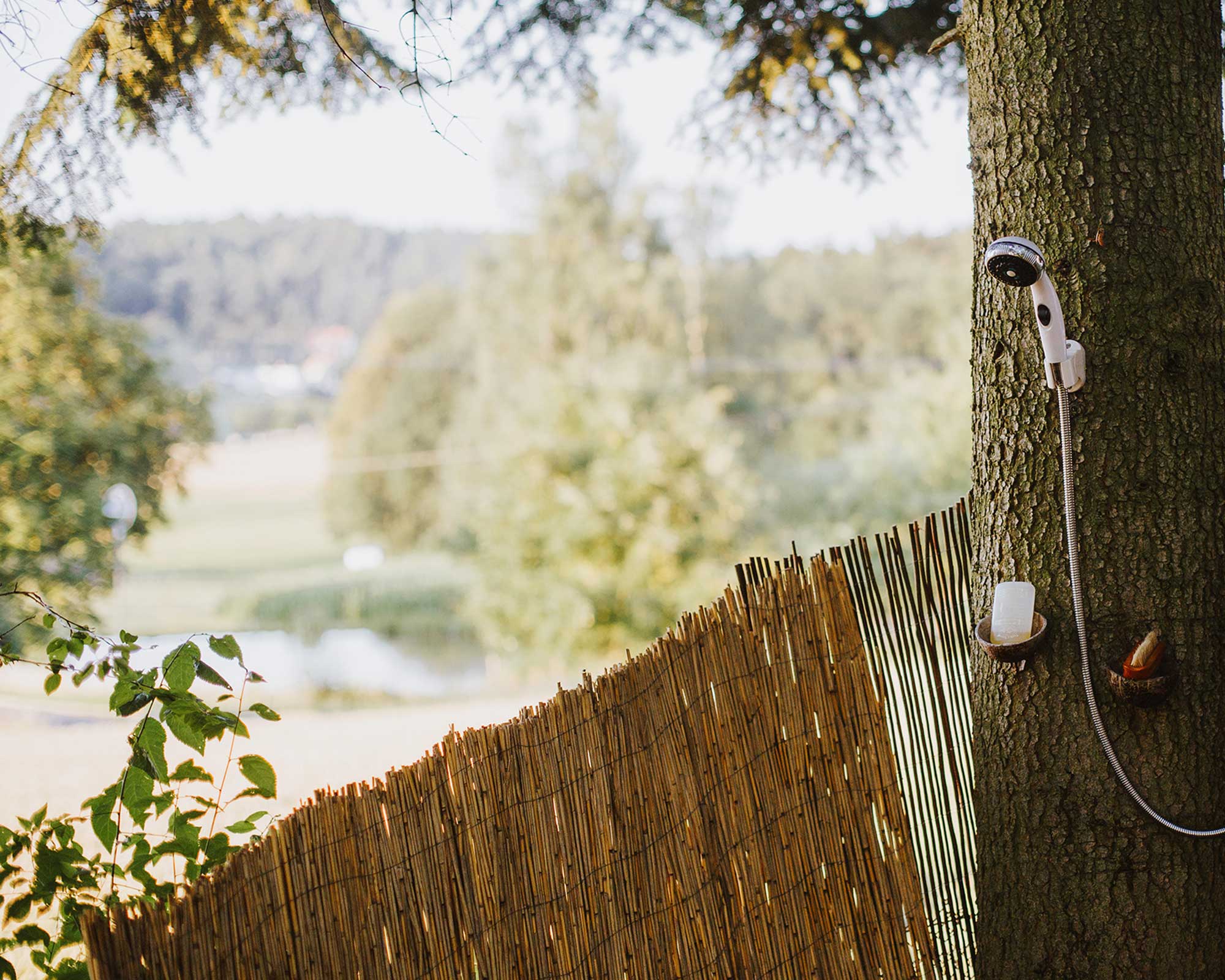
The simplest of shower kits can be hooked up to a hose and then suspended around your garden, including from a tree
Pedestal outdoor showers
'Another option is a pedestal or tower shower, which can be installed anywhere in the garden,' Bailey says. 'These outdoor showers are hooked up to your outdoor plumbing line, so they offer hot and cold water.
'If your pedestal or tower shower features a single, mixed-temperature control, it will also need an anti-scald valve. If you buy a pedestal shower pre-assembled, it may come with this valve already included.'
For this approach, you'll likely need to hire a professional to help with the plumbing side of things.
Wall-mounted outdoor showers
'You can also choose to go with a wall-mounted outdoor shower,' says Bailey. 'These attach to your outdoor plumbing supply and usually to the house itself.'
These showers are often recommended by professional installers, explains Bailey. As they are attached to the exterior wall of the house, there tends to be easy access to the existing hot and cold water lines – therefore the plumbing is less exposed and less expensive (again you will likely need to hire a plumber to help). 'However, they are not portable and you will need to make sure it is set up to drain away from the house,' she adds.
Polly Shearer, an interior design expert at Drench.co.uk, says, 'Shower rail kits are a great option for outdoor showers as they're easy to operate, adjustable, and are great for low budgets.' She adds: 'If you have low water pressure, opting for a water-saving, low-pressure showerhead is a great idea as they infuse air and water, so still ensure a powerful and efficient flow of water whilst keeping costs down.'
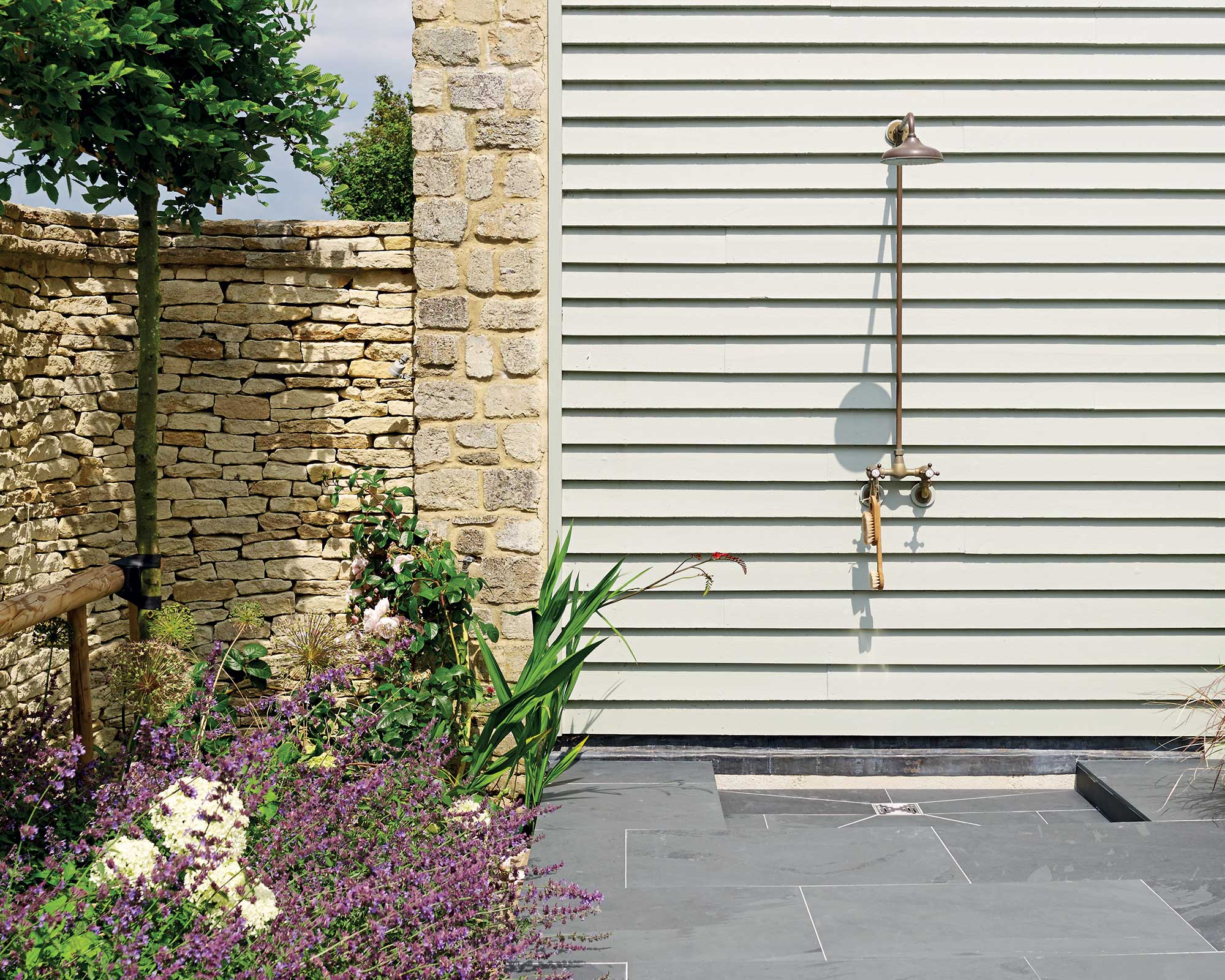
This smart outdoor shower space includes Nero Riven Slate and Cameronstone Tumbled Cobbles, both from Mandarin Stone
2. Consider the materials
For any outdoor bathroom ideas, you need to ensure that the materials you use will stand up to the elements and the test of time.
'In addition to how your outdoor shower looks, you also need to consider how practical it is,' says Bailey of Angi. 'The material choices are key for determining their longevity and durability. With outdoor showers, we recommend durable stainless steel or brass to withstand weathering and corrosion. If possible, opt for marine-grade stainless steel.' Polly also suggests going for stainless steel as it is robust and 'will resist rust and wear and tear from various weather conditions.'
Bailey continues: 'For the base of your shower, what material you use is really up to personal preference. Concrete or stone tiles offer excellent longevity. Wood slats are also a popular option since they can be treated and weatherproofed in the same way as an outdoor patio or deck.'
Polly says, 'We also recommend going for mosaic tiles for your outdoor shower floor, as they're non-porous, anti-slip, and will also look great in a garden setting.'
Bailey continues: 'Whatever you choose, ensure it allows natural drainage.' You can find more info on drainage below.
If you're installing your shower on a raised deck or other platform, try to make sure there is enough space underneath to allow air to flow, as Bailey suggests. 'This will help reduce mildew and mold.'
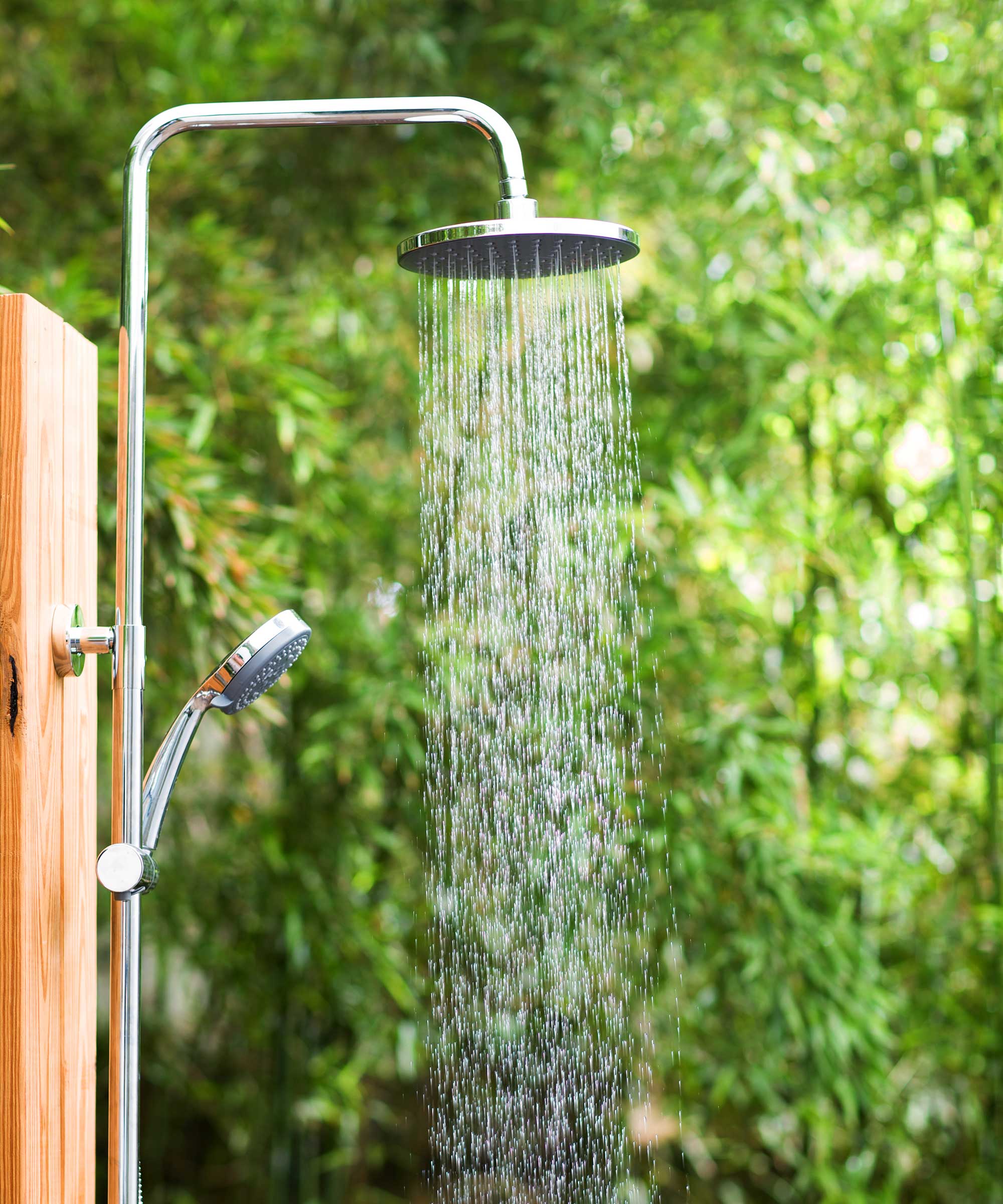
Make sure you choose materials that will withstand the regular exposure to water
3. Don't forget about drainage
Whether you're planning on taking long, luxurious, alfresco showers or just quick rinses now and again, you'll need to give drainage some thought.
'It's important to keep the drainage system efficient to prevent a build-up of water, so try installing your shower on a gradient to keep residue water and puddles to a minimum,' says Polly. The water from your shower (known as gray water) will then naturally run down into the garden, watering your plants. Just be careful to only use eco-friendly washing and cleaning products in your shower to avoid damaging your garden's greenery.
Another option is to create a dry well – which is where a layer of gravel is used to buffer and filter water before allowing it to gradually soak into the soil – similar to a rain garden.
However, if the water doesn't seem to be draining away quick enough, or you are close to the foundations of your home, then you may prefer to opt for a shower pan to catch the water. A pipe can be hooked up to the shower pan to transfer the water away in a more controlled manner to other areas – eg., to your garden border, or to your wastewater system.
Bear in mind that in some areas, any wastewater is required to drain directly into septic or municipal sewer lines, so it's always a good idea to check with your local authority if this applies to you.
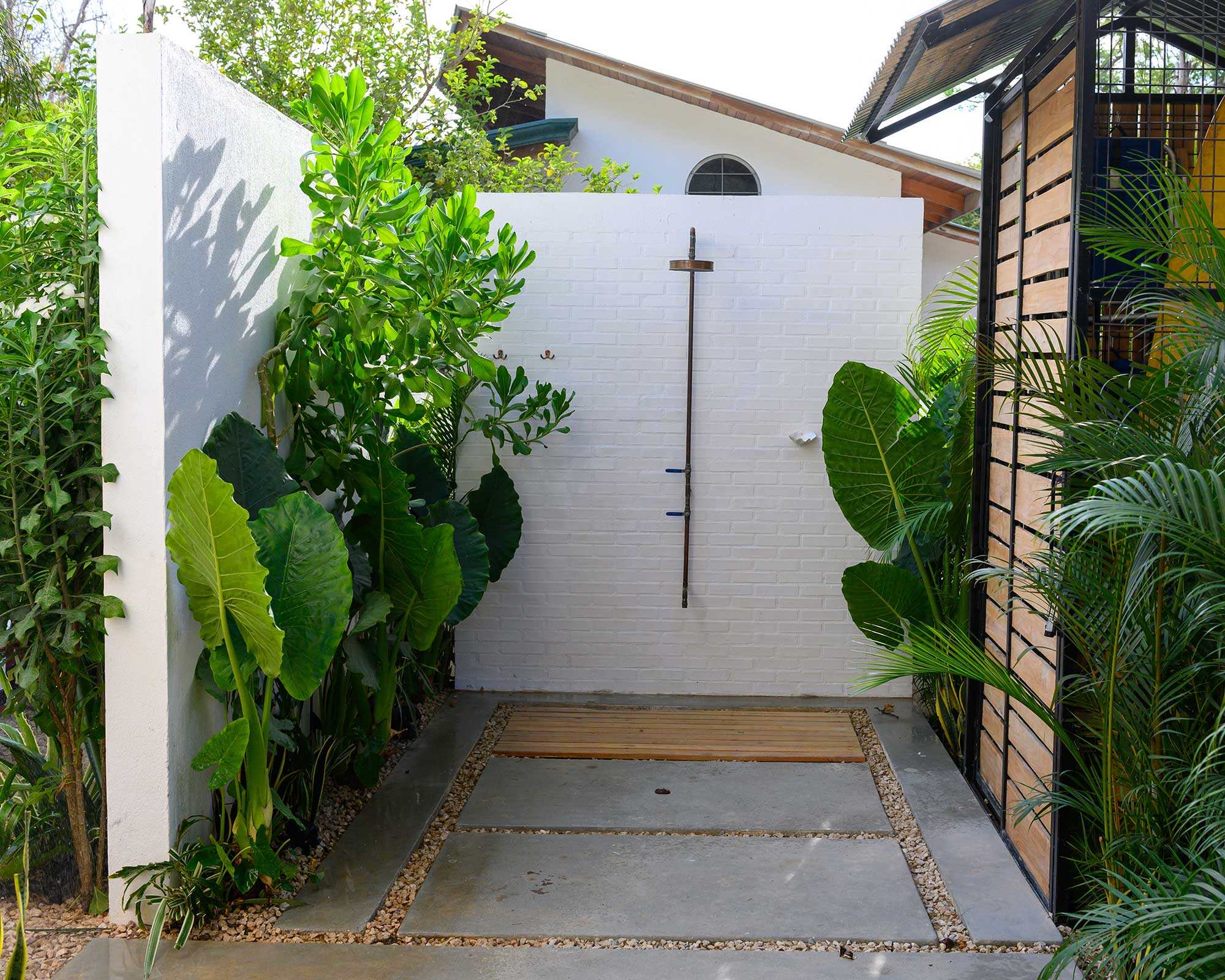
A layer of gravel can help with drainage
4. Protect it from winter weather
If you've read our guide on how to prepare a garden for winter, you'll know that there are lots of jobs to do. And, if you've got an outdoor shower, you may need to add the task of winterizing it to your list.
'As with any outdoor plumbing, the lines to your outdoor shower will need to be protected from winter weather and lower temperatures,' advises Bailey. 'If you're opting for a permanent outdoor shower in an area that experiences frost or snow, be sure to choose a model with frost-proof lines and features. While it may cost more initially, this will ensure the longevity of your shower.
'If your shower isn't frost-proof, you'll need to winterize it each year before the winter hits,' Bailey continues. 'Blowing the lines out will help prevent them from freezing and causing damage.
'If you're not sure how to winterize your outdoor plumbing – including your outdoor shower – it's best to bring in a pro. You can learn how to properly protect your pipes from the cold so your shower will be ready to use come summer.
'Showerheads and handles that detach are also useful in cold climates, as they can be removed and safely stored throughout the colder seasons.'
What can you use for an outdoor shower enclosure?
Many outdoor showers need a bit (or sometimes, a lot) of privacy – which is where an enclosure or screen comes in.
One of the simplest ideas we've seen is attaching a shower curtain around a large hula-hoop secured from up high, but other enclosure ideas include corrugated metal sheets secured to a wooden beam frame, a slatted screen made from pallets or timber, or even a sturdy garden wall. Whatever you choose, ensure it is properly treated to be waterproof – for instance, with a protective layer of paint or wood stain.
For a more versatile option, you could choose a foldable, freestanding screen – ideal as a quick fix if you're adding your shower to an existing patio or deck. There are lots more garden screening ideas in our dedicated feature.
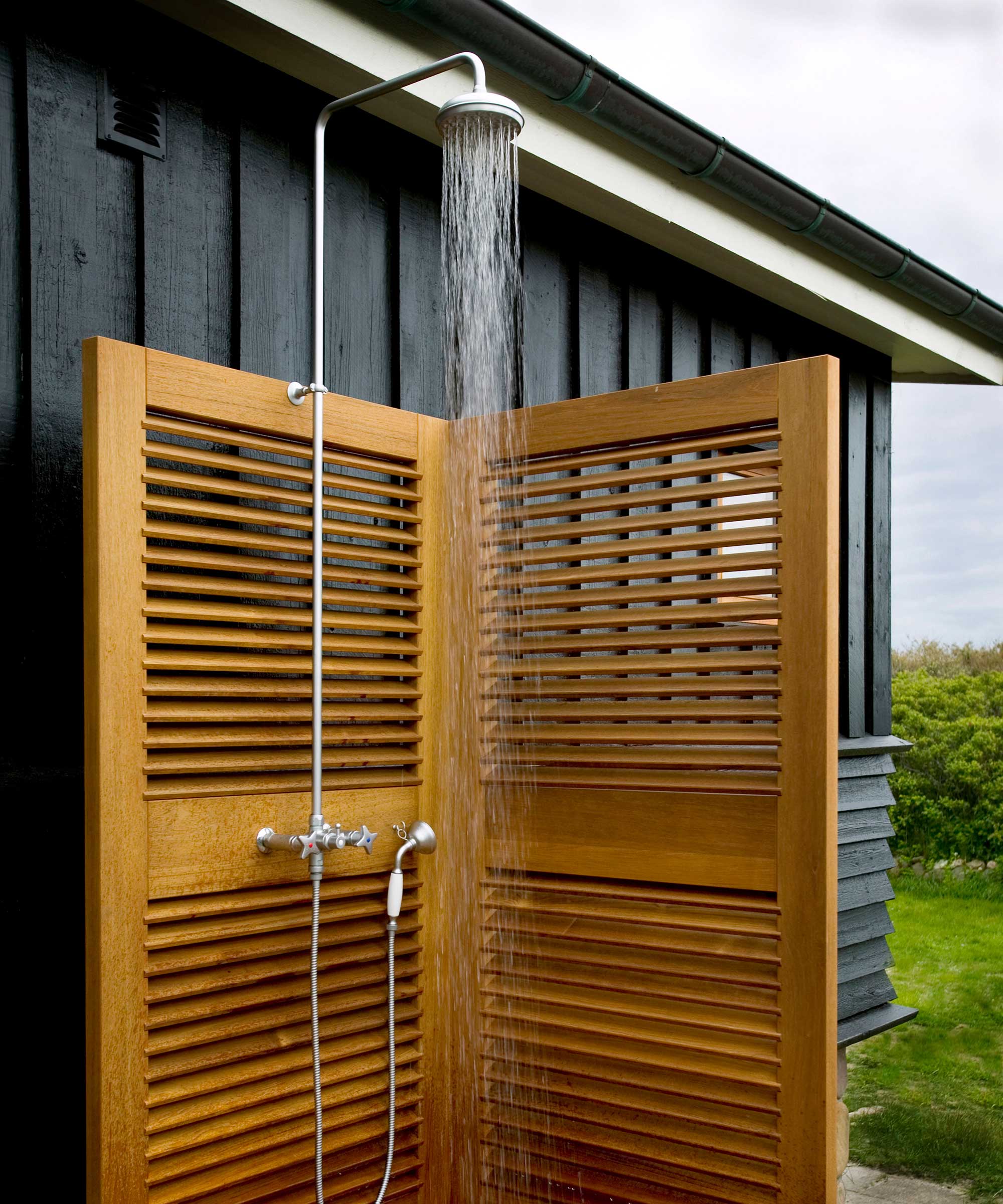
A slatted wooden screen adds style points and privacy to this shower
How should you style your DIY outdoor shower?
There are a few finishing touches you can add to your outdoor shower to elevate it in both practicality and style.
One factor to consider is storage. This can be as simple as a hook or two nearby for hanging up towels or a soap-on-a-rope. But, it could also include benches or shower niches built into the surrounding structure to place shampoo bottles.
You may also want to add some greenery to the scene with a potted plant or two nearby. It's a lovely way to create a relaxing, jungle-like vibe and is a good tip for outdoor bathtub ideas, too.
Also, think about the color scheme, particularly when it comes to the enclosure. Choosing tiles in a tonal palette or adding a lick of outdoor paint can be all it takes to give your space plenty of personality and tie it into the rest of your scheme.

The garden was always a big part of Holly's life growing up, as was the surrounding New Forest where she lived. Her appreciation for the great outdoors has only grown since then. She's been an allotment keeper, a professional gardener, and a botanical illustrator – plants are her passion.
